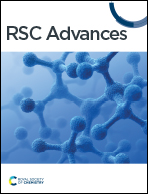Hydroxy silicone oil modified boron nitride for high thermal conductivity and low dielectric loss silicone rubber composites: experimental and molecular simulation studies†
Abstract
Polymer-based composites are widely used in microelectronics and wireless communications, which require high thermal conductivity and low dielectric loss for effective heat dispersion and signal transmission. Different lengths of hydroxyl silicone oil chains modified boron nitride/silicone rubber composites were explored and prepared in this work. Experiments demonstrate that the long-chain modified BN improves the thermal conductivity and decreases the dielectric loss of composites. A molecular dynamics simulation was employed to study the mechanism and affecting variables. The calculated results indicated that the improvement of the thermal and dielectric properties is mainly related to the interfacial behavior, including interfacial compatibility, interfacial bond strength, and phonon matching. Based on the simulated interfacial behavior and thermal conductivity, the thermal and dielectric properties of different chain-length modified boron nitride/silicone rubber composites have been anticipated. The results show that the longer-chain modified boron nitride/silicone rubber composites have better thermal and dielectric properties. This research may give a theoretical foundation for the development of materials with designable performance for electronic devices.



 Please wait while we load your content...
Please wait while we load your content...